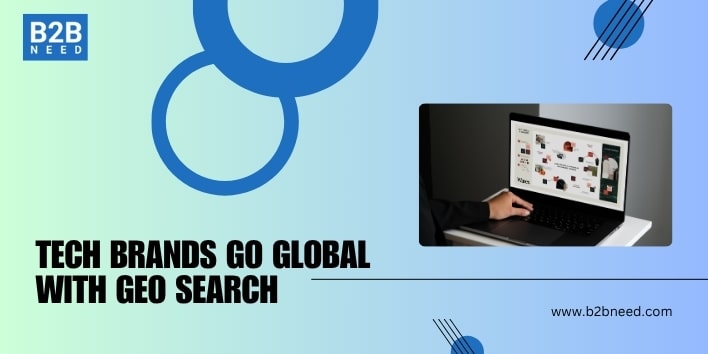Resonance has launched GEO Search, an B2B AI visibility engine that will help B2B technology brands understand how large language models (LLMs) see them during the buyer journey. This groundbreaking tool solves a new problem for marketers, which is to be discoverable not only on search engines, but within generative AI outputs.
“The battle for attention isn’t SEO anymore – it’s being picked by AI,” said Claire Williamson, Founder and CEO of Resonance. “GEO Search offers the insights that brands need to make it into AI-generated recommendations and vendor shortlists.”
How GEO Search operates & why is it so important
GEO Search is a brand visibility analysis of AI-generated response in the B2B technology sector. Examining: – Buyer intent: More than 100,000 buyer intent prompts across 113 tech categories.
- How frequently brands are mentioned by AI models
- The sources and URLs used by LLMs in their responses
- Comparative visibility across competitors in the same sector
The platform processes over 1 million URLs and 946,000 brand mentions which reveal the way in which AI understands brand authority and credibility. According to Resonance research, 89% of B2B buyers now use LLMs to evaluate vendors, which means visibility in AI outputs is fast becoming a critical factor in the buying process.
Key Findings: LLMs and Brand Mention in B2B Purchase
The insights GEO Search has uncovered by searching for brand influence reveal new dimensions of brand influence:
- Earned media drives B2B AI visibility: LLMs cite authoritative publications when shortlisting vendors the most.
- Analyst and peer reviews dominate evaluation: Various sources such as Gartner, G2, IDC, and TrustRadius are referred to quite often across industries.
- Sector-specific citation patterns: Cybersecurity buyers, decision-makers on cloud infrastructure and DevOps professionals have different sources of trust, which means visibility strategies need to be tailored.
This proves that it is no longer enough to use traditional SEO tactics. Brands now have to optimise for visibility in AI, i.e. make sure they are cited and framed appropriately in LLM generated outputs.
Useful Business Applications in Marketing and PR Departments
For B2B tech marketers, GEO Search would be a road map for the influence of AI-based decision making:
- Focus on authoritative mentions: Try to publish content in well-known tech media, analyst content, content targeting industry-specific peer publish, etc. These sources will most likely be cited by LLMs.
- Monitor AI citations: GEO Search makes it possible to track real-time citations of your brand when responding with AI This is beneficial for marketing teams to find holes in their visibility.
- Tailor sector-specific content: Align content with messaging according to what sources and language your target segment of buyers consumes.
- Integrate B2B AI visibility into PR strategy: Press releases, interviews, and case studies should be aimed at improving mentions in high-impact sources that are known to AI.
- Measure and iterate: Develop metrics around share of B2B AI visibility, citations frequency and quality of mentions along with traditional marketing KPIs.
“LLMs have patterns, and those patterns are susceptible to influences,” said Tom Fry, CTO and co-founder of Resonance. “Brands which are strategic about their presence in AI will have a clear edge in buyer consideration.”
Regional Impact: Worldwide B2B Markets, GEO Search
Although GEO Search is a global search, it is not relevant for all markets:
- United States: Tech firms that are among the early adopters are already using B2B AI visibility in marketing and PR campaigns.
- Europe: Regulatory frameworks on AI generated content mean that LLMs input should impact which sources LLMs link to takes impact on brand visibility strategies.
- India and APAC: Fast digitization and massive enterprise tech spending make visibility on AI crucial for startups and large companies looking to provide value to the worldwide recognition.
By giving brands, a clear picture of AI-driven visibility patterns, GEO Search helps marketers to allocate their resources efficiently and make sure their global presence is reflected in the buyer intelligence platforms.
Challenges and Considerations for Enterprises
Even with GEO Search, brands are faced with a number of implementation challenges:
- Source credibility: All the media or analyst citations are not equal in weight in AI outputs.
- Dynamic AI algorithms: LLMs update frequently, requiring ongoing monitoring and adaptation.
- Integration with marketing strategy: Visibility efforts should be integrated with content marketing, SEO, PR and thought leadership campaigns.
- Measurement complexity: Unlike traditional search metrics, AI visibility requires new KPIs and dashboards to assess brand presence effectively.
Marketing teams need to work very closely with PR and content teams to make sure that AI visibility efforts are consistent and sustainable.
The Future of B2B AI Visibility and Vendor Research
As the adoption of generative AI increases, AI visibility will become as important as SEO. Analysts say that queries related to LLMs are expected to overtake traditional search engine queries for B2B vendor research in 2028.
GEO Search is the first step towards a new discipline for B2B brands, which is to actively manage how AI sees, frames and cites their company. Brands that take early to this mindset will:
- Increase inclusion in vendor shortlists from AI
- Improve the perceived authority of buyers
- Align marketing, PR, and content operations with AI-first strategies
The implications are obvious: visibility is no longer confined to search rankings, it spreads to the AI layer, where most of the B2B buying decisions are influenced now.
Key Takeaway
With the introduction of GEO Search, Resonance is setting a new place in the world of B2B technology marketing: intelligence visibility is now a strategic imperative. Marketers need to monitor the mention of their brands in generative AI experiments and optimize for authoritative mentions, as well as incorporate AI visibility metrics into greater marketing strategy. Brands that ignore this change risk becoming invisible to a growing segment of buyers that depend on AI tools to shortlist vendors, evaluate products and make purchase decisions.

